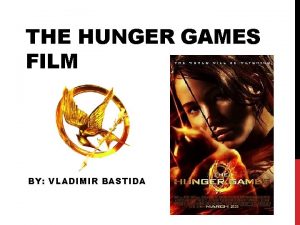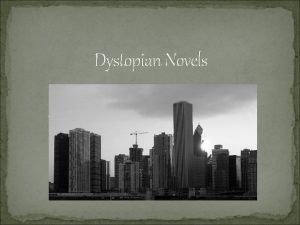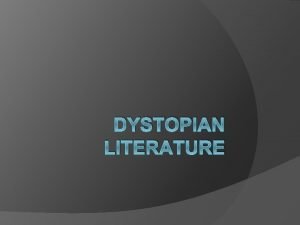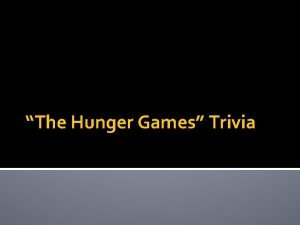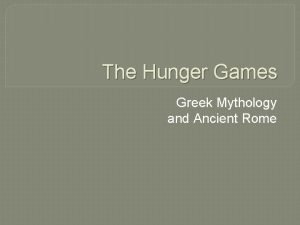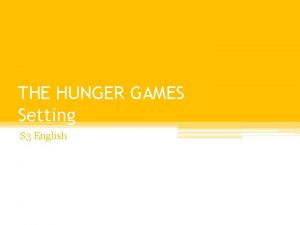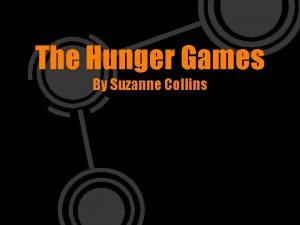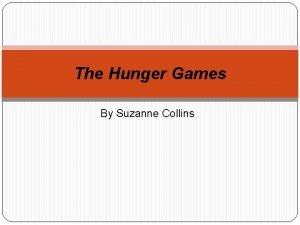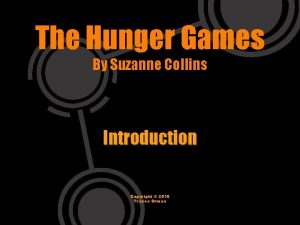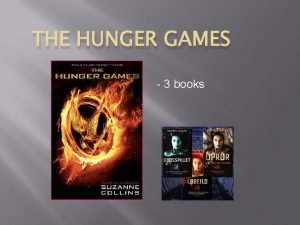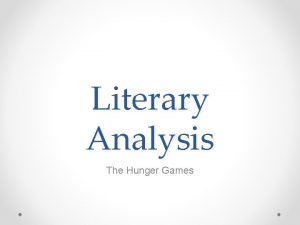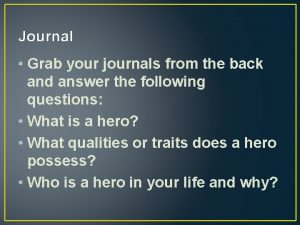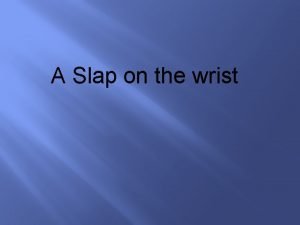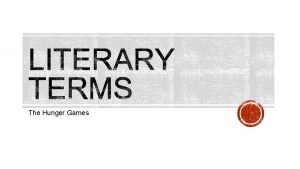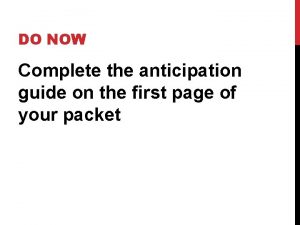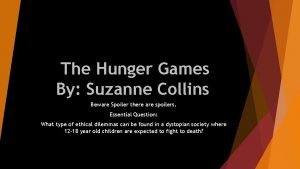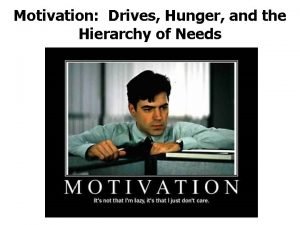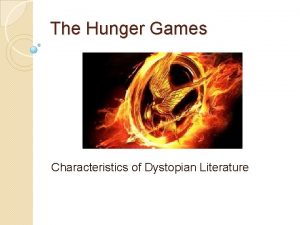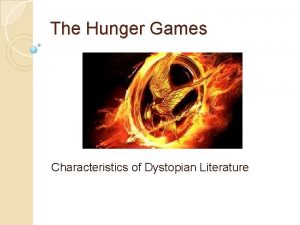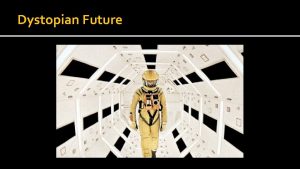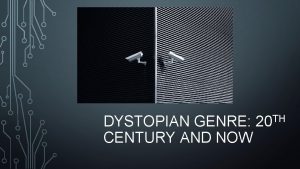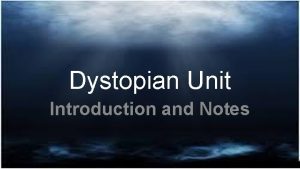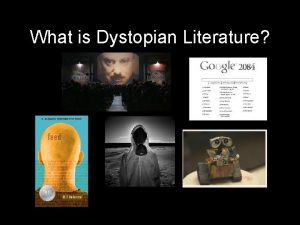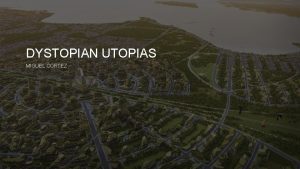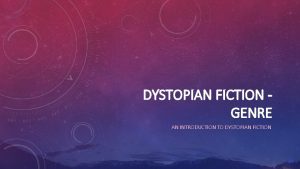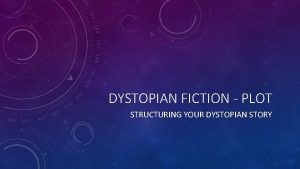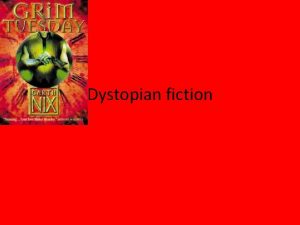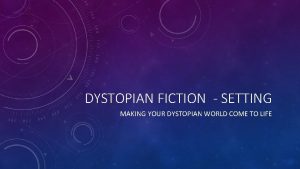Dystopian Voices THE HUNGER GAMES NOVEL AND FILM



















- Slides: 19

Dystopian Voices THE HUNGER GAMES NOVEL AND FILM

Practice Paragraphs Close analysis paragraphs follow the same pattern as body paragraphs in a full length essay. Close analysis is very much like an explanation response, focussing upon the how and why of the text You will need to provide close analysis, even in your interview. Follow this structure: STEELS

Body Paragraph ØS – statement or topic sentence ØT – language technique ØE – example ØE – explanation of the effect and/or purpose of the language technique ØL- link the TEE to answering the question ØS – summarise the information contained in the paragraph; linking back to the topic sentence Each paragraph should contain 2 -3 sets of TEE

Practice Close Analysis Paragraphs Identify and describe some of the dystopian features of District 12 in Chapter 1 of the novel. What is their relationship to the real world? Why is Collins’ use of first person narrator so effective in the novel? How does Ross use contrast to distinguish the values of the Capital from the values of District 12? Describe how Ross has used a variety of film techniques to illustrate theme of loyalty.

Model Practice Comparative Paragraph How does each composer use techniques to establish the Dystopian world? Think about how you would use STEELS to organise this response. ◦ At least one set of TEE for each text.

Comparative paragraph example Each composer uses different techniques to effectively establish the Dystopian world of the text. Collins introduces a new lexicon that is unique to Panem, in the opening chapter, indicating a world slightly different to our own. For example, words like, the ironically named ‘Peacekeepers’, the ‘reaping’ and the ‘Hunger Games’. These words suggest a world of control through fear. Ross is able to use visual contrast to indicate a Dystopian world in which the values of the District clash with the Capital. The undershot of the hovercraft crashing through the forest, from the point of view of Katniss and Gale, creates a contrast between the military technology and power of the Capital with the powerlessness of two young people and their homemade hunting weapons. This type of relationship between the powerful and the powerless is often found in dystopian fiction. Each composer uses techniques appropriate to their medium to establish that a Dystopian world in which the Capital wields almost insurmountable power.

Comparative paragraph example Bold = Language technique Italics = quotation Red = verb that introduces explanation/link Statement - Each composer uses different techniques to effectively establish the Dystopian world of the text. TEE - Collins introduces a new lexicon that is unique to Panem, in the opening chapter, indicating a world slightly different to our own. For example, words like, the ironically named ‘Peacekeepers’, the ‘reaping’ and the ‘Hunger Games’. L - These words suggest a dystopian world of control through fear. TEE - Ross is able to use visual contrast to indicate a Dystopian world in which the values of the District clash with the Capital. The undershot of the hovercraft crashing through the forest, from the point of view of Katniss and Gale, creates a contrast between the military technology and power of the Capital with the powerlessness of two young people and their homemade hunting weapons. L- This type of relationship between the powerful and the powerless is often found in dystopian fiction. Summary - composer uses techniques appropriate to their medium to establish that a Dystopian world in which the Capital wields almost insurmountable power.

Optional Practice Class Task Complete either in full or in part Interview the writer of The Hunger Games novel and the director of The Hunger Games film for an audience of Year 8 students at BCR. In your interview, compare the similarities and differences between the novel and film and discuss how the change in medium has impacted upon the meaning of the texts.

Comparative Interview The interview requires ◦ The content of an essay extended response ◦ The structure of an essay extended response ◦ The style of a conversation

Comparative Interview: The content of an extended response The interview still requires close analysis ◦ Identification of language techniques ◦ Identification of examples ◦ Novel: For example, words like, the ironically named ‘Peacekeepers’, the ‘reaping’ and the ‘Hunger Games’. ◦ Film: description of the scene through the film techniques being identified ◦ E. g. ‘The undershot of the hovercraft crashing through the forest, from the point of view of Katniss and Gale, ’ ◦ Discussion and explanation of the significance and meaning of the quotation and language technique

Comparative Interview: The content of an extended response Use the questions that you ask your interviewees like topic sentences, to control the flow of information. Change the topic sentence from the example above into a question: ØEach composer uses different techniques to effectively establish the Dystopian world of the text. Interviewer: So, Suzanne, could you comment on how you created the dystopian world of the novel? Suzanne: … Interviewer: And how did you manage this Gary? Gary: …

Comparative Interview: The So, Suzanne and Ross, what you content of an extended response are both trying to achieve in your different sentence mediums isthat the dystopic There are two ways to handle the summary you would sense of the Capital wielding normally find in a paragraph. 1. 2. almost insurmountable power The interviewee provides the summary over District 12. Suzanne, can I ask about … question. The interviewer provides the summary as you a rhetorical response statement, and then moves onto the next topic sentence/question. Change the summary sentence from the example above into a type 2 response: ØEach composer uses techniques appropriate to their medium to establish that a Dystopian world in which the Capital wields almost insurmountable power.

Comparative Interview: The structure of an extended response: Introduction Your introduction to the interview scenario functions like the introduction to an essay extended response. ØAcknowledge your audience ØAcknowledge your guests and introduce them ØGive a brief overview of the purpose of the interview ØGive a brief preview of the main points you are going to be discussing Don’t ask about their health, family, transport to the event or anything else that is irrelevant to the interview and your answer to the question. Get straight into the interview.

Comparative Interview: The structure of an extended response: Introduction Interviewer: Hello, Brigidine Year 8 and a special welcome to our guests, Suzanne Collins, author of The Hunger Games and Gary Ross, director of the film of the novel. I would like to ask you both some questions about the similarities and differences between your texts and whether or not the medium has impacted upon the meaning of the text. I’d like to talk to you about how you have created your dystopian worlds and something else. Suzanne, I’ll start with you. How have you created your dystopian world in the novel? Suzanne: Well, I created a lexicon …

Comparative Interview: The structure of an extended response: Conclusion You conclusion to your interview functions like the conclusion to your essay. ØSummarise the main points you have made ØAllow the interviewer to draw the conclusions ØAcknowledge the interviewees and the audience Interviewer: So, Gary, what you are saying is that you created the control rooms scenes to provide insight into what Katniss might be thinking and feeling rather than using a voice over of Katniss’ first person narration for the novel. And that is all we have time for today, so a very big thank you to our guests, Suzanne Collins and Gary Ross. We have learnt a lot about dystopian fiction from you both. Next week we will be talking to Veronica Roth, author of Divergent, and Neil Burger, the director of the film, about the transition from page to screen.

The style of a conversation ØUse first, second and third person ØUse contractions e. g. ØUse speech fillers e. g. So, Well, isn’t it? ØUse question marks ØConstructions that are more like spoken language e. g. So, can I ask you about …, What do you think about … ØMake sure you are using your commas correctly, particularly around names. http: //www. grammarbook. com/punctuation/commas. asp See Rule 5

Layout of the interview ØLabel each speaker clearly ØUse the left hand margin For example: Interviewer: So, Suzanne, could you comment on how you created the dystopian world of the novel? Suzanne: Well, I created a lexicon Interviewer: And how did you manage this, Gary? Gary: The undershot of the hovercraft …

Language of Comparison Key words commonly used to express comparison include: Like, similar, as, same, in the same way too, both, have in common, the same as, similarly, as well as Key words commonly used to express contrast include: Although, yet, whereas, however, but, while, differ, instead, unless, Unlike, on the contrary, contrary to, even though, on the other hand, the reverse

Language of Comparison Note: When you compare one subject to another, you show the two are alike, or similar. Example: The dog, like the cat, is a household pet. When you contrast two subjects, you show they are different. Example: The dog, unlike the cat, is dependent on its master. Sometimes, both comparison and contrast are used in the same sentence. Example: Both the dog and the cat make good household pets, but a dog requires more attention than a cat.
 Hunger games chapter 27
Hunger games chapter 27 Hunger games film study
Hunger games film study Dystopian novels definition
Dystopian novels definition Definition of dystopian literature
Definition of dystopian literature Nuts and volts hunger games
Nuts and volts hunger games Hunger games chapter 13 questions and answers
Hunger games chapter 13 questions and answers Hunger games theseus and the minotaur
Hunger games theseus and the minotaur The hunger games settings
The hunger games settings What is the richest district in the hunger games
What is the richest district in the hunger games Hunger games tessera
Hunger games tessera The hunger games copyright
The hunger games copyright Suzanne marie collins
Suzanne marie collins How does katniss plan to strike at the careers
How does katniss plan to strike at the careers Hunger games introduction paragraph
Hunger games introduction paragraph The hunger games a hero's journey begins
The hunger games a hero's journey begins Paraffin definition hunger games
Paraffin definition hunger games Direct characterization in the hunger games
Direct characterization in the hunger games The hunger games anticipation guide
The hunger games anticipation guide Hunger games spoiler
Hunger games spoiler Drive-reduction theory meme
Drive-reduction theory meme

